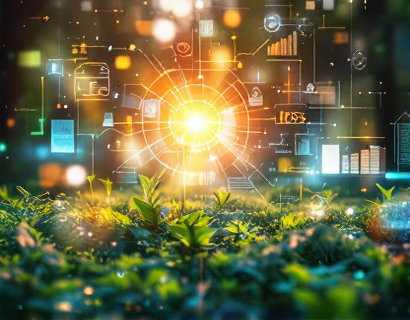Elevate Farming and Horticulture: Harnessing Advanced Analytics for Sustainable Resource Management and Enhanced Yields
In the quest for sustainable agriculture, the integration of advanced analytics plays a pivotal role in transforming farming and horticulture practices. By leveraging sophisticated environmental analytics, farmers and horticulturists can optimize resource management, enhance crop yields, and contribute to a healthier planet. This article delves into the transformative potential of data-driven insights in the agricultural sector, focusing on how modern tools and technologies can elevate traditional practices to new heights of efficiency and sustainability.
The Importance of Sustainable Resource Management
Sustainable resource management is not just a buzzword; it is a necessity for the future of farming and horticulture. With the global population projected to reach 9.7 billion by 2050, the demand for food, water, and other agricultural resources is increasing at an unprecedented rate. Traditional farming methods often lead to overuse of resources, soil degradation, and environmental degradation. Advanced analytics offers a solution by providing precise and real-time data that can guide farmers in making informed decisions, ensuring that resources are used efficiently and sustainably.
Advanced Analytics in Action
Environmental analytics software, such as the innovative platforms available today, can process vast amounts of data from various sources including soil sensors, weather stations, and satellite imagery. This data is then transformed into actionable insights that can optimize irrigation, fertilization, and pest management. For instance, precision irrigation systems can adjust water usage based on real-time soil moisture levels, reducing water waste and ensuring that crops receive exactly what they need when they need it.
Moreover, these systems can predict weather patterns and climate changes, allowing farmers to plan their planting and harvesting schedules more effectively. By understanding the likelihood of droughts or excessive rainfall, farmers can take proactive measures to protect their crops and minimize losses. This level of foresight not only enhances yield but also reduces the environmental impact of farming activities.
Enhancing Crop Yields Through Data-Driven Decisions
One of the most significant benefits of advanced analytics in farming and horticulture is the potential to boost crop yields. By analyzing historical data and current conditions, farmers can identify the optimal conditions for growth, including soil composition, nutrient levels, and optimal planting densities. This information can be used to tailor farming practices to the specific needs of each crop, leading to healthier plants and higher yields.
For example, precision agriculture techniques involve using GPS and sensor technology to apply fertilizers and pesticides only where they are needed, in the exact amounts required. This targeted approach not only saves costs but also reduces the environmental footprint of these chemicals. Additionally, data analytics can help in identifying the best crop varieties for specific regions and conditions, further enhancing productivity.
Promoting Sustainable Practices
Sustainability is at the core of modern farming and horticulture. Advanced analytics supports sustainable practices by providing tools that monitor and reduce the environmental impact of agricultural activities. For instance, by optimizing the use of water and fertilizers, these systems help in minimizing runoff and pollution, protecting local ecosystems and water sources. Furthermore, data-driven insights can guide farmers in adopting regenerative practices such as crop rotation, cover cropping, and organic farming, which improve soil health and biodiversity.
Another critical aspect of sustainability is the reduction of greenhouse gas emissions. Advanced analytics can help in optimizing machinery usage and reducing fuel consumption, thereby lowering the carbon footprint of farming operations. By providing real-time data on equipment performance and efficiency, farmers can make adjustments to their operations to be more energy-efficient and environmentally friendly.
Case Studies and Real-World Applications
Several farming and horticulture operations have already seen significant benefits from implementing advanced analytics. In one notable case, a large-scale vegetable farm in the United States used precision agriculture techniques to monitor soil health and moisture levels. By integrating data from soil sensors and weather forecasts, the farm was able to reduce water usage by 30% and increase crop yields by 15%. This not only improved the farm's profitability but also reduced its environmental impact.
In another example, a horticulture company in Europe utilized data analytics to optimize its greenhouse operations. By analyzing temperature, humidity, and light levels, the company was able to create ideal growing conditions for a variety of plants, resulting in a 20% increase in yield. The data-driven approach also allowed for early detection of pest infestations, enabling timely interventions that minimized the use of chemical pesticides.
Challenges and Considerations
While the benefits of advanced analytics in farming and horticulture are clear, there are several challenges that need to be addressed. One of the primary concerns is the initial cost of implementing these technologies. High-quality sensors, software, and infrastructure can be expensive, particularly for small-scale farmers. However, the long-term savings and increased productivity often justify the investment.
Another challenge is the need for technical expertise to effectively use and interpret the data. Farmers and horticulturists must be trained in data analysis and interpretation to fully leverage the insights provided by analytics platforms. Educational programs and support services can play a crucial role in bridging this knowledge gap.
The Future of Farming and Horticulture
As technology continues to advance, the potential for innovation in farming and horticulture is vast. The integration of artificial intelligence, machine learning, and the Internet of Things (IoT) is set to revolutionize the way we approach agriculture. Smart farming systems will become more autonomous, with machines and drones performing tasks such as planting, monitoring, and harvesting with minimal human intervention. These advancements will not only increase efficiency but also make farming more accessible and sustainable.
Moreover, the global shift towards sustainable and regenerative agriculture will be significantly supported by advanced analytics. As consumers become more conscious of the environmental impact of their food choices, there is a growing demand for products that are not only high-quality but also produced using sustainable methods. Analytics will play a key role in meeting this demand by providing the tools needed to produce food in a way that preserves the planet for future generations.
In conclusion, the integration of advanced analytics in farming and horticulture is a transformative force that can lead to more sustainable resource management and enhanced crop yields. By embracing these technologies, farmers and horticulturists can make informed decisions, optimize their operations, and contribute to a healthier and more resilient agricultural system. The path to sustainable agriculture is data-driven, and the future looks promising for those who embrace it.










































